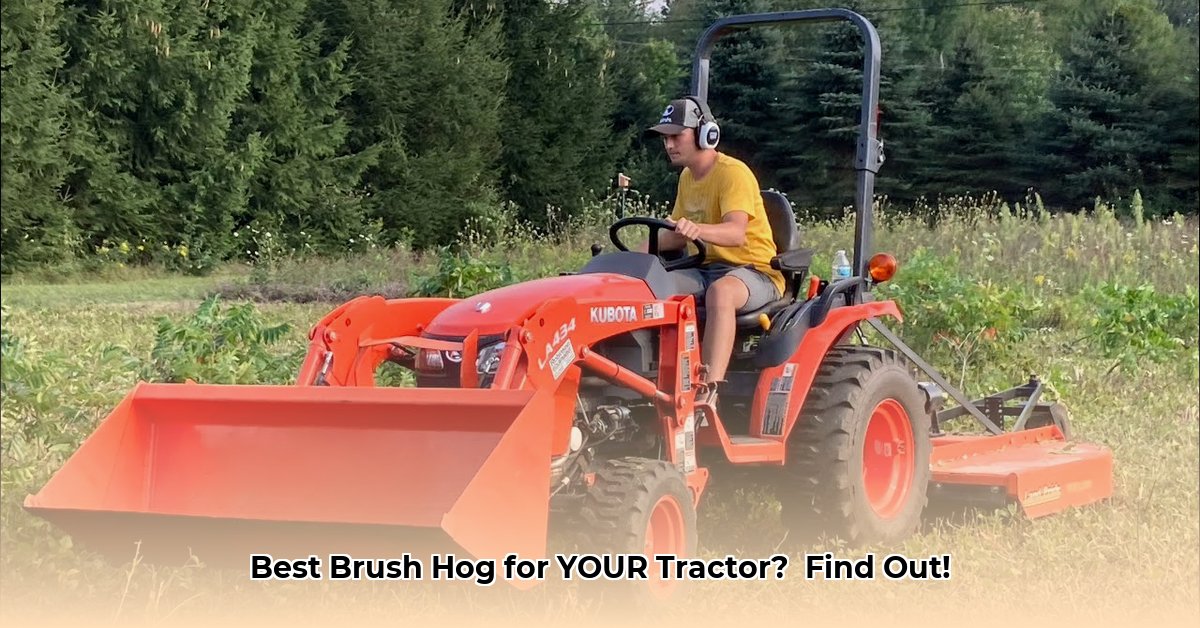
Brush Hog for Tractor: Choosing the Right Rotary Cutter
Choosing a brush hog (rotary cutter) for your tractor requires careful consideration of several factors. This comprehensive guide will help you navigate the options and select the best brush hog for your specific needs and budget. We'll compare major brands, explore key features, and provide a step-by-step buying guide, ensuring you make a smart, long-term investment. For more detailed information on tractor brush hog setups, check out this helpful resource: Tractor Bush Hog Guide.
Understanding Your Needs: Assessing Your Land and Tasks
Before exploring specific models, assess your land and the tasks you need to accomplish. What type of vegetation are you dealing with? Delicate pasture grasses require a different approach than dense brush or small saplings. The acreage also matters; a small yard requires a different cutter than a large farm. The thickness and toughness of the vegetation will greatly influence your choice. Heavier brush requires a more robust machine. And, critically, what is your tractor's horsepower? Mismatching the brush hog to your tractor can damage both and lead to inefficiency.
Key Features and Considerations: Specifying Your Requirements
Several key features differentiate brush hogs. Understanding these will help narrow your choices.
Cutting Width: A wider cutting width covers more ground per pass, increasing efficiency. However, wider cutters generally require more tractor horsepower. What is the optimal balance for your acreage and tractor capabilities?
Blade Type: Blades are designed for different vegetation types. Some are ideal for light grass, while others are built for tougher brush and even small trees. What type of vegetation is your primary focus, and which blade type best suits it?
Gearbox: The gearbox is a crucial component. A robust gearbox ensures longevity and smooth operation. A well-designed gearbox is vital to long-term reliability. What gearbox design is known for its durability?
Material Construction: The steel type and thickness impact durability and resistance to damage from rocks or other obstructions. Higher-strength steels, like Hardox 450, offer superior protection but at a higher cost. Is the increased durability worth the premium cost?
Safety Features: Safety is paramount. Features like slip clutches protect your tractor's drivetrain in case of unexpected impacts. What safety features are essential for your operating environment?
Comparing Leading Brands: A Balanced Perspective
The brush hog market includes established players and newer entrants. Let's consider two examples to illustrate the range of options:
| Feature | Bush Hog | Everything Attachments | Other Brands (e.g., Rhino, Woods) |
|---|---|---|---|
| Reputation | Long-standing, highly reliable, extensive dealer support | Newer company, innovative materials, growing reputation | Varies widely; research individual brands thoroughly |
| Material Focus | Traditional robust steel | High-strength steel (Hardox 450 & others) | Mix of materials, depending on model and price |
| Cutting Performance | Proven effective | Potentially superior due to advanced materials | Varies; some models excel in specific conditions |
| Cost | Generally higher | Can be more affordable; pricing varies greatly | Wide price range, depending on size and features |
| Dealer Support | Excellent, widespread network | Expanding network; geographic availability may vary | Varies widely; check your local availability before purchasing |
Bush Hog: Bush Hog enjoys a long-standing reputation for reliability and durability, backed by a substantial dealer network for ease of parts and service. However, their products generally come at a higher price point.
Everything Attachments: Everything Attachments often uses advanced materials, potentially offering longer life and better cutting performance. They can offer more competitive pricing. However, their longevity and dealer support might be less established compared to Bush Hog.
This comparison isn't exhaustive. Numerous reputable brands offer varying features and price points. Thorough research is crucial to find the best option.
Maintenance for Longevity: Essential Practices
Proper maintenance significantly extends a brush hog's lifespan. Regular care prevents costly repairs and ensures consistent performance.
Blade Sharpening: Regularly sharpen or replace dull blades to maintain cutting efficiency and reduce stress on the machine. Dull blades are less effective and increase the risk of damage.
Lubrication: Follow the manufacturer's recommendations for lubricating all moving parts. Consistent lubrication is crucial for preventing wear and tear.
Gearbox Inspection: Regularly inspect the gearbox for leaks or unusual noises. Address any problems promptly to prevent major damage.
Regular Inspections: Conduct routine inspections to identify any wear and tear, loose bolts, or other damage early on.
The choice of materials affects longevity. High-strength steels like Hardox 450 provide exceptional resistance to wear and tear, but come with increased initial costs.
Your Brush Hog Buying Guide: A Step-by-Step Approach
- Assess Your Needs: Carefully consider your land type, vegetation, and acreage.
- Match Horsepower: Ensure your tractor has sufficient horsepower for the chosen brush hog.
- Set a Budget: Determine your budget, considering initial cost, maintenance, and potential repairs.
- Research Brands: Compare various brands, read reviews, and check warranties.
- Compare Specifications: Carefully review cutting width, blade type, gearbox, steel type, and safety features.
- Choose a Dealer: Opt for a dealer providing excellent parts and service support.
The correct brush hog is a substantial investment impacting productivity and long-term cost-effectiveness. Careful planning and comprehensive research will ensure you choose the brush hog best suited to your specific needs and budget. Remember, the ideal choice is determined by your specific requirements. Don't settle for anything less than the best match for your farm or property.